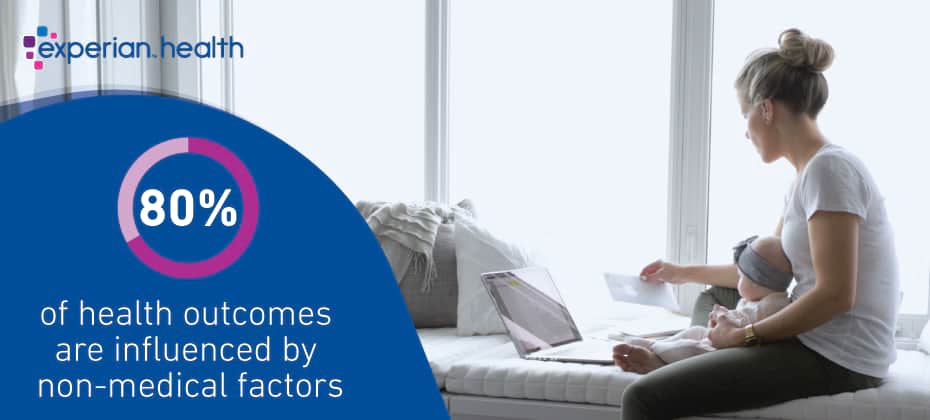
It’s a puzzle many healthcare providers are still working to solve: when over 80% of health outcomes are influenced by non-medical factors, how can health systems help their patients achieve better outcomes?
From affording time off work so they can attend an appointment, to accessing healthy food, childcare or transport, your patients’ ability to engage with and benefit from health services can be heavily influenced by a host of social and economic dynamics
Understanding these social determinants of health (SDOH) gives you a more complete picture of your patients’ health and life circumstances. You can anticipate their needs, coordinate their care more effectively, and ultimately give them a better healthcare experience. What’s more, harnessing the right data on SDOH leads to smarter investment and operational decisions, yielding advantages for your health system as a whole.
That’s why many providers are starting to use non-medical consumer data in their care management planning. Here we look at some of the top use cases for SDOH data.
5 top use cases for data on social determinants of health
- Reduce missed appointments
No-shows cost providers an average of $200 each (plus a lot of wasted physician time). Often these are down to lack of access to transportation or childcare. SDOH data can help you anticipate where these challenges might occur, so you can offer additional services like a free shuttle bus or crèche.
You’ll make the experience a little easier for the patient, and potentially prevent an unchecked health issue from becoming something more serious.
- Save costs from preventable health events
Unfortunately, life circumstances can lead to many people using health services in a way that could be avoided. Missed appointments or difficulty following a care plan can lead to escalating medical issues, entailing more treatment and readmissions. Patients might also fall back on emergency services because they can’t easily access appropriate alternatives.
SDOH data helps you understand the circumstances that might lead to this kind of patient behavior. For example, if you can spot patients who may be likely to dial 911 because they have no other way to get to the health services they need, you can offer alternatives that avoid an unnecessary visit to the ED.
This could help you save up to $2000 per Emergency Department visit and around $10,000 for each hospital stay (which often can’t be fully reimbursed if the patient ends up being readmitted).
- Increase care plan compliance
A patient’s living situation can often determine whether or not they’ll be able to stick to their care plan. For example, specific dietary advice can be a real challenge for a diabetic patient if they have a limited food budget, lack of time to shop and prepare food, or a plain lack of options of where to buy it. An SDOH needs assessment can flag this in advance so clinicians can help patients find a plan that will work for them.
Similarly, pharmacies might use consumer data to help minimize abandoned prescriptions or situations where a patient fails to follow dosage directions, which is estimated to cost the industry $290 billion per year.
- Save administrative and clinical time
Analyzing consumer data can help your operations run more efficiently, which benefits your patients through well-coordinated care, timely information sharing and prompt referrals. Many providers are taking advantage of automated solutions for leveraging SDOH data, saving massive amounts of administrative time for care managers by pre-populating patient data and automating SDOH needs assessments.
Consumer insights solutions like Experian Health’s ConsumerView analytics can optimize operational efficiencies and ensure your care managers use their time well.
- Investing in relevant community health programs
One of the most impactful use cases for SDOH data is to gain a richer understanding of your member base, so you can invest in the most relevant community health programs.
For example, a 2018 pilot project by Atrium Health in North Carolina screened for food insecurity in older patients who may have been at risk of readmission. Emergency food services were provided where needed, and as a result, readmissions dropped by 60%.
Your purchasing power can also be a force for change. The Cleveland Clinic outsourced its laundry service to Evergreen Cooperative Laundry, a local collaborative working to combat poverty. Ralph Turner, executive director of patient support services at the Cleveland Clinic says: “Establishing the foundation for people to stabilize their incomes and become part owners in a business… in itself generates health and wellbeing in our community.”
Leveraging consumer data to improve patient outcomes
These examples show some of the varied ways screening for social determinants of health can open the door to understanding your patients and creating truly person-centered care services.
Who knows what opportunities are hidden in the SDOH data for your patient population? Are there gaps in your data? Could you combine different data sets for a fuller picture? What exactly is your consumer data telling you, and how do you turn it into meaningful management decisions?
At Experian Health, we have comprehensive data assets and analytics platforms to help you answer these questions and more, and leverage consumer data most effectively.


